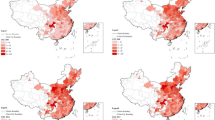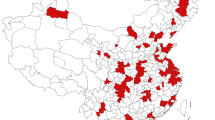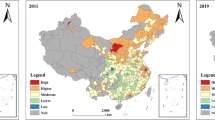Abstract
Today, low-carbon development and smart city pilots are prevalent. Against this backdrop, an urgent need exists to clarify the impact of smart city construction on low-carbon development. However, studies on the low-carbon development effects of smart city construction remain scarce. Therefore, this in-depth study focuses on China, the world’s largest developing country, to examine the role of smart city construction in promoting low-carbon development. First, we calculate the carbon total factor productivity of 182 prefecture-level cities in China using the slacks-based global Malmquist–Luenberger index. Second, to empirically examine the impact of smart city construction on carbon total factor productivity, we employ a multi-period difference-in-difference (DID) model and a machine learning-based propensity score matching DID (PSM-DID) model. The results reveal that smart city construction significantly enhances carbon total factor productivity and low-carbon technological efficiency, while its impact on low-carbon technological progress is nonsignificant. Mechanism tests indicate that smart city construction can improve carbon total factor productivity through the following three channels: green technological innovation, industrial structure upgrading, and resource allocation. Heterogeneity tests indicate that all three batches of smart city construction improve carbon total factor productivity, and that the positive effect of the third batch is greater than that of the first and second batches. Furthermore, the carbon total factor productivity promotion effect of smart city construction is stronger in megacities and cities in the central region. Finally, we propose relevant policy implications.
Graphical abstract






Similar content being viewed by others
Data availability
All the data and code used for analysis in this study are available from the corresponding author upon reasonable request.
Notes
Data source: BP statistical review of world energy 2022.
References
Aguilera G, Galán JL, Campos JC, Rodríguez P (2013) An accelerated-time simulation for traffic flow in a smart city. FEMTEC 2013:26
Bai C, Du K, Yu Y, Feng C (2019) Understanding the trend of total factor carbon productivity in the world: insights from convergence analysis. Energy Econ 81:698–708
Beretta I (2018) The social effects of eco-innovations in Italian smart cities. Cities 72:115–121
Bhujabal P, Sethi N, Padhan PC (2021) ICT, foreign direct investment and environmental pollution in major Asia Pacific countries. Environ Sci Pollut Res 28(31):42649–42669
Bibri SE, Krogstie J (2017) On the social shaping dimensions of smart sustainable cities: a study in science, technology, and society. Sustain Cities Soc 29:219–246
Cai M, Kassens-Noor E, Zhao Z, Colbry D (2023) Are smart cities more sustainable? An exploratory study of 103 US cities. J Clean Prod 416:137986
Calvillo CF, Sánchez-Miralles A, Villar J (2016) Energy management and planning in smart cities. Renew Sustain Energy Rev 55:273–287
Caragliu A, Del Bo CF (2019) Smart innovative cities: the impact of Smart City policies on urban innovation. Technol Forecast Soc Chang 142:373–383
Chen J (2023) Mitigating nitrogen dioxide air pollution: the roles and effect of national smart city pilots in China. Energy 263:125652
Chen Y, Huang D, Liu Z, Osmani M, Demian P (2022) Construction 4.0, Industry 4.0, and Building Information Modeling (BIM) for sustainable building development within the smart city. Sustainability 14(16):10028
Chen J, Abbas J, Najam H, Liu J, Abbas J (2023) Green technological innovation, green finance, and financial development and their role in green total factor productivity: empirical insights from China. J Clean Prod 382:135131
Chu Z, Cheng M, Yu NN (2021) A smart city is a less polluted city. Technol Forecast Soc Chang 172:121037
Chung YH, Färe R, Grosskopf S (1997) Productivity and undesirable outputs: a directional distance function approach. J Environ Manag 51(3):229–240
Delitheou V, Meleti V, Athanassopoulos CG (2019) Green economy and smart city. J Reliab Intell Environ 5:235–240
Dong F, Li Y, Li K, Zhu J, Zheng L (2022) Can SCC improve urban ecological total factor energy efficiency in China? fresh evidence from generalized synthetic control method. Energy 241:122909
Drucker J, Feser E (2012) Regional industrial structure and agglomeration economies: an analysis of productivity in three manufacturing industries. Reg Sci Urban Econ 42(1–2):1–14
Fan S, Peng S, Liu X (2021) Can smart city policy facilitate the low-carbon economy in China? A quasi-natural experiment based on pilot city. Complexity 2021:1–15
Färe R, Grosskopf S, Pasurka CA Jr (2007) Environmental production functions and environmental directional distance functions. Energy 32(7):1055–1066
Feng Y, Hu S (2022) The effect of smart city policy on urban haze pollution in China: empirical evidence from a quasi-natural experiment. Pol J Environ Stud 31(3):2083
Ferrara R (2015) The smart city and the green economy in Europe: a critical approach. Energies 8(6):4724–4734
Fukuyama H, Weber WL (2009) A directional slacks-based measure of technical inefficiency. Socioecon Plann Sci 43(4):274–287
Gao Y, Zhang M, Zheng J (2021) Accounting and determinants analysis of China’s provincial total factor productivity considering carbon emissions. China Econ Rev 65:101576
Giffinger R, Fertner C, Kramar H, Meijers E (2007) City-ranking of European medium-sized cities. Cent Reg Sci Vienna UT 9(1):1–12
Jiang H, Jiang P, Wang D, Wu J (2021) Can SCC facilitate green total factor productivity? A quasi-natural experiment based on China’s pilot smart city. Sustain Cities Soc 69:102809
Kitchin R (2014) The real-time city? Big data and smart urbanism. GeoJournal 79:1–14
Lara AP, Da Costa EM, Furlani TZ, Yigitcanlar T (2016) Smartness that matters: towards a comprehensive and human-centred tylizedization of smart cities. J Open Innov Technol Mark Complex 2(2):1–13
Lee BK, Lessler J, Stuart EA (2010) Improving propensity score weighting using machine learning. Stat Med 29(3):337–346
Li X, Fong PS, Dai S, Li Y (2019) Towards sustainable smart cities: an empirical comparative assessment and development pattern optimization in China. J Clean Prod 215:730–743
Li X, Shu Y, Jin X (2022) Environmental regulation, carbon emissions and green total factor productivity: a case study of China. Environ Dev Sustain 24(2):2577–2597
Liu Y, Li Q, Zhang Z (2022) Do smart cities restrict the carbon emission intensity of enterprises? Evidence from a quasi-natural experiment in China. Energies 15(15):5527
Liu K, Meng C, Tan J, Zhang G (2023) Do smart cities promote a green economy? Evidence from a quasi-experiment of 253 cities in China. Environ Impact Assess Rev 99:107009
Luo J, Wang Z, Wu M (2021) Effect of place-based policies on the digital economy: evidence from the Smart City Program in China. J Asian Econ 77:101402
Oh DH (2010) A global Malmquist-Luenberger productivity index. J Prod Anal 34:183–197
Peng H, Bohong Z, Qinpei K (2017) Smart city environmental pollution prevention and control design based on Internet of Things. In: IOP Conference series: earth and environmental science. IOP Publishing, p. 012174
Qian L, Xu X, Zhou Y, Sun Y, Ma D (2023) Carbon emission reduction effects of the smart city pilot policy in China. Sustainability 15(6):5085
Sergi BS, Berezin A, Gorodnova N, Andronova I (2019) Smart cities and economic growth in Russia. Modeling economic growth in contemporary Russia. Emerald Publishing Limited, pp 249–272
Shen Q, Wu R, Pan Y, Feng Y (2023) The effectiveness of smart city policy on pollution reduction in China: new evidence from a quasi-natural experiment. Environ Sci Pollut Res 30(18):52841–52857
Solow RM (1956) A contribution to the theory of economic growth. Quart J Econ 70(1):65–94
Song T, Dian J, Chen H (2023) Can SCC improve carbon productivity? A quasi-natural experiment based on China’s smart city pilot. Sustain Cities Soc 92:104478
Stamopoulos D, Dimas P, Siokas G, Siokas E (2024) Getting smart or going green? Quantifying the Smart City Industry’s economic impact and potential for sustainable growth. Cities 144:104612
Tang J, Li Y (2024) Study on the impact of smart energy on carbon emissions in smart cities from single and holistic perspectives–Empirical evidence from China. Sustain Cities Soc 101:105145
Townsend AM (2013) Smart cities: big data, civic hackers, and the quest for a new utopia. WW Norton & Company
Wang F (2023) Does the construction of smart cities make cities green? Evidence from a quasi-natural experiment in China. Cities 140:104436
Wang J, Deng K (2022) Impact and mechanism analysis of smart city policy on urban innovation: evidence from China. Econ Anal Policy 73:574–587
Wang X, Zhong M (2023) Can digital economy reduce carbon emission intensity? Empirical evidence from China’s smart city pilot policies. Environ Sci Pollut Res 30(18):51749–51769
Wang H, Cui H, Zhao Q (2021a) Effect of green technology innovation on green total factor productivity in China: evidence from spatial durbin model analysis. J Clean Prod 288:125624
Wang M, Xu M, Ma S (2021b) The effect of the spatial heterogeneity of human capital structure on regional green total factor productivity. Struct Chang Econ Dyn 59:427–441
Wang KL, Pang SQ, Zhang FQ, Miao Z, Sun HP (2022a) The impact assessment of smart city policy on urban green total-factor productivity: evidence from China. Environ Impact Assess Rev 94:106756
Wang L, Wang H, Cao Z, He Y, Dong Z, Wang S (2022b) Can industrial intellectualization reduce carbon emissions? Empirical evidence from the perspective of carbon total factor productivity in China. Technol Forecast Soc Chang 184:121969
Weber G, Cabras I (2017) The transition of Germany’s energy production, green economy, low-carbon economy, socio-environmental conflicts, and equitable society. J Clean Prod 167:1222–1231
Whata A, Chimedza C (2022) Evaluating uses of deep learning methods for causal inference. IEEE Access 10:2813–2827
Wu J, Xia Q, Li Z (2022) Green innovation and enterprise green total factor productivity at a micro level: a perspective of technical distance. J Clean Prod 344:131070
Xin B, Qu Y (2019) Effects of smart city policies on green total factor productivity: evidence from a quasi-natural experiment in China. Int J Environ Res Public Health 16(13):2396
Xu G, Yang Z (2022) The mechanism and effects of national smart city pilots in China on environmental pollution: empirical evidence based on a DID model. Environ Sci Pollut Res 29(27):41804–41819
Xu N, Ding Y, Guo J (2022) Do smart city policies make cities more innovative: evidence from China. J Asian Public Policy 15(1):1–17
Xue F, Zhou M, Liu J (2023) Are cities saving energy by getting smarter? Evidence from smart city pilots in China. Sustainability 15(4):2961
Yigitcanlar T, Kamruzzaman M (2018) Does smart city policy lead to sustainability of cities? Land Use Policy 73:49–58
Yu Y, Zhang N (2019) Does smart city policy improve energy efficiency? Evidence from a quasi-natural experiment in China. J Clean Prod 229:501–512
Yu D, Liu L, Gao S, Yuan S, Shen Q, Chen H (2022) Impact of carbon trading on agricultural green total factor productivity in China. J Clean Prod 367:132789
Zhang G, Lin B (2018) Impact of structure on unified efficiency for Chinese service sector: a two-stage analysis. Appl Energy 231:876–878
Zhang D, Vigne SA (2021) How does innovation efficiency contribute to green productivity? A financial constraint perspective. J Clean Prod 280:124000
Acknowledgements
The authors acknowledge the financial support provided by Humanity and Social Science Youth Foundation of Ministry of Education of China (21YJC790051).
Funding
This work was supported by Humanity and Social Science Youth Foundation of Ministry of Education of China (21YJC790051), Social Science Foundation of Hubei Province, China (23ZD222) and the “Fundamental Research Funds for the Central Universities”, Zhongnan University of Economics and Law (2722024BQ012).
Author information
Authors and Affiliations
Contributions
Zhongqi Wu contributed to conceptualization, writing—original draft, methodology, software, resources, and data curation. Xuliang Wang contributed to conceptualization, writing—original draft, writing—review and editing, and funding acquisition.
Corresponding author
Ethics declarations
Conflict of interest
The authors declare no competing interests.
Ethics approval
Not applicable.
Consent to participate
Not applicable.
Consent for publication
Not applicable.
Additional information
Publisher's Note
Springer Nature remains neutral with regard to jurisdictional claims in published maps and institutional affiliations.
Appendix
Appendix
See Tables 7, 8, 9, 10 and 11.
Rights and permissions
Springer Nature or its licensor (e.g. a society or other partner) holds exclusive rights to this article under a publishing agreement with the author(s) or other rightsholder(s); author self-archiving of the accepted manuscript version of this article is solely governed by the terms of such publishing agreement and applicable law.
About this article
Cite this article
Wu, Z., Wang, X. The impacts of smart city construction on carbon total factor productivity: empirical evidence from China. Clean Techn Environ Policy (2024). https://doi.org/10.1007/s10098-024-02865-4
Received:
Accepted:
Published:
DOI: https://doi.org/10.1007/s10098-024-02865-4




